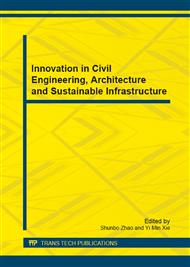[1]
Alina Badanoiu, Jonas Holmgren et al, Cementitious composites reinforced with continuous carbon fibers for strengthening of concrete structures, Cement and Concrete Composites, 25 (2003) 387-394.
DOI: 10.1016/s0958-9465(02)00054-9
Google Scholar
[2]
A. E. Naaman, H. W. Reinhardt, High performance fiber reinforced cement composites HPFRCC-4: International workshop Ann Arbor, Michigan, Cement and Concrete Composites, 6 (2004) 757-759.
DOI: 10.1016/j.cemconcomp.2003.09.001
Google Scholar
[3]
Andrzej M. Brandt, Fibre reinforced cement-based (FRC) composites after over 40 years of development in building and civil engineering, Composite Structures, 86 (2008) 3-9.
DOI: 10.1016/j.compstruct.2008.03.006
Google Scholar
[4]
Yoshihiko Ohama, Recent progress in concrete-polymer composites, Advanced Cement Based Materials, 5 (1997) 31-40.
DOI: 10.1016/s1065-7355(96)00005-3
Google Scholar
[5]
H. Hashimoto, Y. Ohama, Polymer modified mortars, The Journal of the College of Engineering of Nihon University, Series A, 19 (1978) 113-117.
Google Scholar
[6]
J. M. Gao, C. X. Qian, B. Wang, K. E. Morino, Experimental study on properties of polymer modified cement mortars with silica fume, Cement Concrete Res., 32 (2002) 41-45.
DOI: 10.1016/s0008-8846(01)00626-3
Google Scholar
[7]
J. G. Wang, S. X. Zhang, et al, Reinforced polymer concrete: Physical properties of the matrix and static/dynamic bond behaviour, Cement Concrete Comp., 27 (2005) 934-944.
DOI: 10.1016/j.cemconcomp.2005.06.004
Google Scholar
[8]
Y. Ohama, Polymer-based admixtures, Cement Concrete Comp., 20 (1998) 189-212.
DOI: 10.1016/s0958-9465(97)00065-6
Google Scholar
[9]
S. Pascal, A. Alliche, P. Pilvin, Mechanical behaviour of polymer modified mortars, Mater. Sci. Eng.: A, 380 (2004) 1-2.
DOI: 10.1016/j.msea.2004.03.049
Google Scholar
[10]
C. T. Sumathy, M. Dharakumar, M. Sarojadevi, S. Saccubai, Modification of cement mortars by polymer latex, J Appl. Polym. Sci., 63 (1997) 1251-1257.
DOI: 10.1002/(sici)1097-4628(19970307)63:10<1251::aid-app2>3.0.co;2-j
Google Scholar
[11]
L. K. Aggarwal, P. C. Thapliyal, S. R. Karade, Properties of polymer-modified mortars using epoxy and acrylic emulsions, Constr Build Mater., 21 (2007) 379-383.
DOI: 10.1016/j.conbuildmat.2005.08.007
Google Scholar
[12]
S. Zhong, Z. Chen, Properties of latex blends and its modified cement mortars, Cement Concrete Res., 32 (2002) 1515-1524.
DOI: 10.1016/s0008-8846(02)00813-x
Google Scholar
[13]
H. Wang, E. H. KO, Y. S., J. K. Jeon, J Ind. Eng. Chem., 26 (2008) 265-271.
Google Scholar
[14]
T. Sebök, O. Stráněl, Wear resistance of polymer-impregnated mortars and concrete, Cement Concrete Res., 34 (2004) 1853-1858.
DOI: 10.1016/j.cemconres.2004.01.026
Google Scholar
[15]
J. Y. Do, Y. S. Soh, Performance of polymer-modified self-leveling mortars with high polymer–cement ratio for floor finishing, Cement Concrete Res., 33 (2003) 1497-1505.
DOI: 10.1016/s0008-8846(02)01057-8
Google Scholar
[16]
Y. Ohama, Recent progress in concrete-polymer composites, Adv. Cement Base Mater., 5 (1997) 31-40.
Google Scholar
[17]
L. Verdolotti, E. D. Maio, M. Lavorgna, S. Iannace, L. Nicolais, Polyurethane-cement-based foams: Characterization and potential uses, J Appl. Polym. Sci., 107 (2008) 1-8.
DOI: 10.1002/app.24997
Google Scholar
[18]
J. Nascimento, H. O. Martinelli A.E., D. M. A. Melo, A. C. V. Nóbrega, D. M. H. Martinelli, Pinto E.N.M.G. Polymers, Nanocomposite Systems with Photo-Electro-Ionic Properties and Applications, Mater. Sci. Forum., 591 (2005) 423-429.
DOI: 10.4028/www.scientific.net/msf.591-593.423
Google Scholar
[19]
O. Lorenz, F. Haulena, O. Klebon, Rubber elastic behavior of polyurethane ionomers, Angew. Makromol Chem., 33 (1973) 159-165.
Google Scholar
[20]
O. Lorenz, H. Hick, Investigation of the particle surface of anionic polyurethane dispersions with COO‐groups, Angew Makromol Chem., 72 (1978) 115-117.
Google Scholar
[21]
Z. P. Bazant, M. T. Kazemi, Determination of fracture energy, process zone length and brittleness number from size effect with application to rock and concrete, Int. J Fract., 44 (1990) 111-131.
DOI: 10.1007/bf00047063
Google Scholar
[22]
S. L. Xu, Y. H. Zhao, et al, The experimental study on the fracture energy of concrete using wedge splitting specimens, J. Hydroelectric Eng., 4 (2003) 15-17 (in Chinese).
Google Scholar


